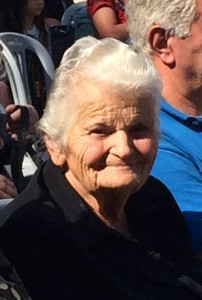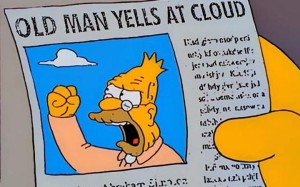Category — ageism
Facing — DEFEATING — ageism
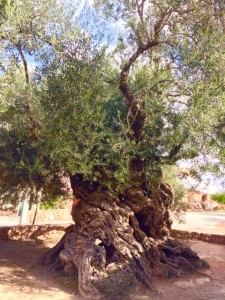 Among the countless things that anger (stun, depress, disgust, worry) me these days is institutionalized ageism. Yes, I said ageism. Not racism, sexism, homophobia. Well, of course racism, sexism, homophobia. But those -isms and –phobias are at least part of our national conversation. We have created policies around them. They are discussed in schools, in the media, on the lecture circuit. I am not saying we have conquered these forms of discrimination, just that we are aware of them and sometimes do the right thing. Although now less than before.
Among the countless things that anger (stun, depress, disgust, worry) me these days is institutionalized ageism. Yes, I said ageism. Not racism, sexism, homophobia. Well, of course racism, sexism, homophobia. But those -isms and –phobias are at least part of our national conversation. We have created policies around them. They are discussed in schools, in the media, on the lecture circuit. I am not saying we have conquered these forms of discrimination, just that we are aware of them and sometimes do the right thing. Although now less than before.
And then there’s ageism.
It is not just firmly embedded in our culture, it is mostly invisible — thanks to the imposed and self-imposed ghetttoization of the elderly (from nursing homes to retirement “communities”). And accepted virtually without question. Old people? Hell, yeah. They are frail, useless, boring, sexless. The street signs show us what we think: A silhouette of a stooped (oh that dowager’s hump) old lady grasping a cane. She can hardly place one foot ahead of another. Watch her struggle as she totters, oh-so-slowly, across the street.
Presumably we all have a soft spot in our hearts for our old people – grandpa, great aunt Tillie, old cousin Bill – but we lose patience with everyone else’s. The grandma at the grocery store. She’s looking through her cavernous handbag for coupons. She’s taking forever to count out the change from her purse. She’s holding up the line. Come on. The geezer in the car, the one whose gray head you can barely see above the top of the driver’s seat. He’s driving 22 in a 35 mph zone. He’s actually making a full stop at the stop sign and looking both ways before proceeding. Get off the road.
And maybe even, sometimes, we lose it with our own kin. Grandpa (Dad) pulls out the old photo album. Again. He launches into the story about…fill in the blank. Again. We roll our eyes and find the first excuse to leave the room.
Old and in the way.
Really?
I am about to go to my weekly volunteer stint at Food for Lane County’s Dining Room where we feed (restaurant-style not soup-kitchen style) 300 or so people every day. For some this will be the only meal they eat all day. Although there are a few younger volunteers, most who work these shifts are retirement-age and some are decades past retirement age. This place, like so many other volunteer-staffed social service agencies, could not exist without OLDER PEOPLE giving their time and energy.
Yes, I said ENERGY.
The Dining Room shift is two hours of constant movement. A number of us wait tables, taking (and remembering) orders, bringing plates of food balanced up our forearms, and glasses of milk and mugs of coffee on laden trays. One volunteer constantly circulates with a big dessert tray. Another constantly circulates bussing and cleaning tables. In the back, people are scrapping huge pots and pans, chopping bushels of apples, working the steamy dish pit. This is not easy work. I clock two miles on a shift and often work up a sweat.
My co-workers – many in their 70s, some in their 80s and at least one in his 90s – work just as hard.
Because, my friends: This is what OLD really looks like.
I want to replace the image of the “don’t hit this frail old lady” street signs with empowering images of the older people in our midst. I want our heads, individually and societally, to be brimming with images of vibrant, engaged older people, funny, feisty, perceptive, talented, passionate, compassionate older people. Older people who not only have experience but still seek it. I want to be that kind of older person.
The photo is of a 3000-year-old olive tree (in Crete). Which is doing just fine. And bears olives every year.
April 12, 2017 3 Comments
Lessons learned from a 3000-year-old olive tree
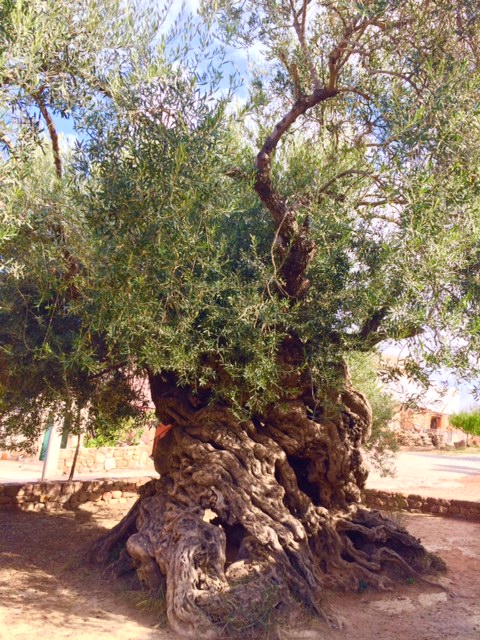 In Vouvres, a village in the mountains of western Crete, there stands an olive tree that is verifiably 3000 years old. When this tree was a sapling, the Iron Age had just begun. The tree is magnificently gnarled, a twisting, turning, ropey, veiny, sinewy work of art that manages to seem both fluid and solid at the same time. Its circumference measures 41 feet. Branches, so many branches, some old and thick, some young and slender, all healthy, all dusty green with leaves, all bearing olives, grow from its massive trunk.
In Vouvres, a village in the mountains of western Crete, there stands an olive tree that is verifiably 3000 years old. When this tree was a sapling, the Iron Age had just begun. The tree is magnificently gnarled, a twisting, turning, ropey, veiny, sinewy work of art that manages to seem both fluid and solid at the same time. Its circumference measures 41 feet. Branches, so many branches, some old and thick, some young and slender, all healthy, all dusty green with leaves, all bearing olives, grow from its massive trunk.
I stood before this tree last week. I couldn’t get enough of it. I walked around and around it. I photographed it from all sides. I peered inside its dark, hollow core. I touched it. I (embarrassingly) spoke to it.
Not out loud.
Okay, sort of out loud.
I asked it to reveal its secrets. How do you survive for three millennia? How do you persevere through all that has come your way? How do you stay so strong, so healthy, so magnificent?
And this is what the Monumental Olive Tree of Vouvres (its official name) told me (not out loud):
**Situate yourself in a place that suits you and grow your roots deep.
**Bend when you have to.
**Be useful
**Give back not just to those who care for and tend you, but to all.
**Keep pushing out new branches. Always push out new branches. Never stop growing.
**And remember the true beauty of age, the complexity and richness, the layering of experience upon experience, the strength and power that comes from that.
“And lady,” the tree said to me, “it’s time to quit talking to trees. Take a hike in the hills. The sun is shining. The bougainvillea is blooming. The air smells like thyme and basil and lavender. Go.”
And so I did.
November 2, 2016 5 Comments
Old and NOT in the way
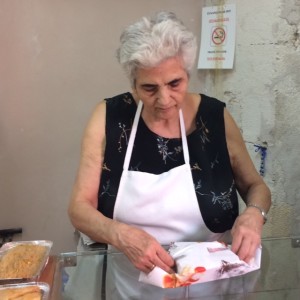 Among the many differences between life in Europe and life in the U.S., one of the most consistently startling to me is how many old people you see…everywhere: behind counters in the shops, rolling out dough in bakeries, strolling on the streets, waiting for buses, shopping in grocery stores, socializing in cafes, sitting on benches and reading the newspaper, enjoying concerts. In other words, they are a visible part of their community. A normal part of everyday life. This woman, In Rethymnon (Crete) and her husband own a phyllo bakery. They are in their 80s.
Among the many differences between life in Europe and life in the U.S., one of the most consistently startling to me is how many old people you see…everywhere: behind counters in the shops, rolling out dough in bakeries, strolling on the streets, waiting for buses, shopping in grocery stores, socializing in cafes, sitting on benches and reading the newspaper, enjoying concerts. In other words, they are a visible part of their community. A normal part of everyday life. This woman, In Rethymnon (Crete) and her husband own a phyllo bakery. They are in their 80s.
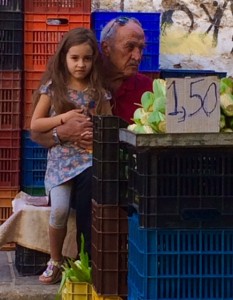 This man sells produce from his farm at the Minoos Market (Chania, Crete) every Saturday. His granddaughter — or it could be his great granddaughter — comes to help. When I bought tomatoes from him, he guided her to make the correct change for me.
This man sells produce from his farm at the Minoos Market (Chania, Crete) every Saturday. His granddaughter — or it could be his great granddaughter — comes to help. When I bought tomatoes from him, he guided her to make the correct change for me.
This 90-year-old woman, a resident of Elos, in the mountains of western Crete, is sitting out on a sunny day enjoying the festivities of the town’s annual chestnut festival. In between the rousing music and traditional dancing (she taps her feet and nods her head), she chats with family and passersby. When I asked if I could take her picture, she laughed and patted my arm.
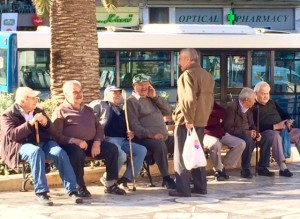 These guys are sitting on sunny bench outside the Agora, Chania’s central marketplace. I sat and watched them for almost half an hour as they chatted, laughed, argued, called out to friends who passed by and generally looked like they were enjoying the morning and each others’ company. And — a big and here — being out in the community, feeling part of the vibrant life of this small city.
These guys are sitting on sunny bench outside the Agora, Chania’s central marketplace. I sat and watched them for almost half an hour as they chatted, laughed, argued, called out to friends who passed by and generally looked like they were enjoying the morning and each others’ company. And — a big and here — being out in the community, feeling part of the vibrant life of this small city.
I think of the difference between the lives these older people live and the ones lived in the US by the elderly (and not even old old, but just retirees in their 60s and 70s). The healthy post-retirement Americans, many of them, are opting to live in gated communities among their own kind, in secluded enclaves, no longer a vital part of their families or of a multi-generational culture. Our healthy older people go to retirement “villages” that are not villages at all. Our unhealthy elderly are warehoused in nursing homes.
We will never defeat ageism if we don’t live together, if older people do not publicly and actively participate in their communities, if young people don’t see and know and interact everyday with older people.
October 26, 2016 7 Comments
Old. Yeah. So what?
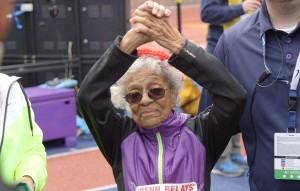 The world – well, 3.5 billion of us, at least — just spent 17 days watching highly trained, super-disciplined, extraordinary physical specimens show us what a human body can do. Those Olympic performances were both inspirational and aspirational, weren’t they? I don’t mean that watching Simone Biles inspired me to want to be Simon Biles, to do what she does. Ha. I mean that marveling at her performances might inspire me (us) to push ourselves, to embrace (or at least entertain) the notion that we can move forward in bold and astonishing ways. We might aspire to the attitude behind her performance, the fierce determination that we are not defined or limited by our past. Her story inspires us more than her (unattainable) physical prowess.
The world – well, 3.5 billion of us, at least — just spent 17 days watching highly trained, super-disciplined, extraordinary physical specimens show us what a human body can do. Those Olympic performances were both inspirational and aspirational, weren’t they? I don’t mean that watching Simone Biles inspired me to want to be Simon Biles, to do what she does. Ha. I mean that marveling at her performances might inspire me (us) to push ourselves, to embrace (or at least entertain) the notion that we can move forward in bold and astonishing ways. We might aspire to the attitude behind her performance, the fierce determination that we are not defined or limited by our past. Her story inspires us more than her (unattainable) physical prowess.
Now that we have celebrated the Olympics, and now that we’re sated with images of hard-bodies who’ve devoted most of their young lives to athletic performance, how about celebrating much older people (much older people) who have attained equally lofty heights of physical achievement. Consider those profiled in a recent special edition of New York Times’ “Well” blog.
Here’s a story about Anna Sofia Botha, 74, the coach of the South African runner who broke the long-standing 400-meter world record. The news media flocked to her (after all, a WHITE HAIRED LADY!!!), clamoring for interviews. Surprised, she replied: “The whole coaching scenario is an everyday way of life for me.” Gotta love it.
Or how about this story profiling a 100-year-old runner. Says Ida Keeling, who started running at 67, “Time marches on, but I keep going.”
Or read about Tao Porchon-Lynch, 97, a competitive ballroom dancer (she started at 80) and a yoga teacher, who says, “I haven’t finished learning.”
When we see Olympic athletes compete, we don’t dismiss their performances as “the exception that proves the rule” – the rule being that almost none of us look like they do and can do what they do. Instead, we enjoy their achievement and are motivated by it. Maybe we can work on adopting that same attitude about these older “outliers.”
These women (and many others — you’d be surprised how many others) are outside the norm, just like the Olympic athletes. Let’s not dismiss them as exceptions that prove the (well entrenched) “rule” about older people, the rule that states that old means frail, feeble and fragile; that old people live constricted, restricted sad little lives. How about, just as we admire those Olympians and are inspired by their stories, we enjoy the stories of world-class (older) women and embrace the attitude behind their achievements? How about that?
August 24, 2016 1 Comment
Mary Berry is scrummy
 Whaaaat? You’ve never heard of Mary Berry?
Whaaaat? You’ve never heard of Mary Berry?
Mary Berry is a household word and a national treasure – in the U.K. She is a culinary superstar, the author of 75– yes, I said 75 – cookbooks, and the co-star of one of my most favorite TV shows EVER, “The Great British Bake Off” (now in season 7).
Two years ago, she launched a new solo show on BBC, “Mary Berry Cooks.” Last year she launched another BBC show, “Mary Berry’s Absolute Favourites.”
She is both quick-witted and thoughtful, funny, smart and gracious with a bearing that manages to be both regal and down-home domestic. And – just icing on the Victoria sponge cake – she’s a looker.
I mention all this and bring Mary Berry to your attention not just because The Great British Bake Off is the best show ever and you ought to see how the Brits do “reality TV” – with intelligence and humor and, gee, kindness. (Yes, even in competition….no “You’re fired” or “You’re chopped.”) I bring Mary Berry to your attention because she is 81.
And NO ONE MAKES A BIG DEAL ABOUT IT. There’s no: Wow she has so much energy for her age. Look what she is accomplishing at her age. I wonder how she does it at her age.
Because age is not the point. Because she is who she is. Because she transcends age and, in doing so, compels us to confront and eschew our own ageism.
I love Mary Berry. Mary Berry is scrummy.
July 26, 2016 3 Comments
Old redefined
I’ve come to realize that old is whatever age you are not yet. When I was in second grade, I could not imagine ever being as old as Teresa DiNapoli, my 17-year-old babysitter, who wore eye make-up (quite a lot, in fact) and went on dates and sneaked out to the backyard to smoke Parliaments while I watched cartoons. And then, all of a sudden, I was 17 (alas, both mascara-less and dateless – but I did sneak cigarettes). And 17 was no longer old.
In college, I thought 30 was old. I mean really old. Settled, boring, embarrassingly unhip. And then I was 30. And I wasn’t boring (I thought). But oh those 40 year olds – how ossified they were. And, of course 60 was absolutely ancient and absolutely unimaginable. Sixty-five was when, weathered and beaten down, creaky, crabby (or, alternately, sweet and grandmotherly) you spent your days complaining about ailments, tending violets and baking cookies.
Yeah, yeah, Bernie mounted the most energetic campaign possibly in the history of campaigning at age 74. And Grandma Moses didn’t start painting seriously until she was 78. And sure, Ruth Bader Ginsburg is rocking it on the bench at 83. But whenever we hear about active, engaged, interesting people who are 70 or 80 or older, they are presented as the exceptions that prove the rule. The rule, as we all know, is that old people are creaky, crabby creatures who totter around (if they’re lucky), eat mushy food and hold up the line at the grocery store by writing checks. Checks.
Regardless of the millions of role models out there who disprove the “old and in the way” mentality of the not-quite-as-old, regardless of our own experiences through life which prove that what we thought was old turns out not to be (when we ourselves get to that age), the stereotypes persist.
That’s why I loved loved loved this video in which the young come face to face with their ageism and emerge much wiser. It is very much worth a look. So please do.
July 13, 2016 3 Comments
We are the change
Ironic – sad, disappointing, anger-inducing – that at the same time we see a vibrant, tireless, full-throttle 74-year-old criss-crossing the country and invigorating voters young and old, at the same time we see millions more people living healthy, engaged and meaningful lives into their 70s, 80s and beyond, we have made so little progress in confronting and defeating ageism. Harmful, negative (and erroneous) stereotypes of older people remain deeply embedded in our culture — and especially in our language.
Ever hear of (or practice) “elderspeak”? It is a sweetly belittling form of address (simple sentences delivered louder and slower than normal conversation) that is, essentially, babytalk directed to mature adults. How are we (why “we”?) doing today, dear? Elderspeak is patronizing, condescending and based on insulting and misguided stereotypes about aging, and the cognitive and communicative abilities of older people.
Or how about these insults masquerading as compliments?
Gee, you don’t look your age!
As a columnist for HuffPost writes: What did you expect a 50/60/70-year-old to look like? A crypt-keeper? We know the intention behind the comment is harmless, but it’s actually not a compliment. It’s just reinforcing the belief that old is automatically unattractive/decrepit/not sexy.
Wow, you still do that?
(“That” meaning: working, performing, hiking…) “Still” is one of those words that reeks of ageism. She’s 60 and still running marathons! She’s 70 and practicing law! The word “still” is a qualifier here and expresses the belief that the activity is unnatural for someone of that age. Because, of course, someone of that age should be sitting on a porch rocker and knitting.
Boy, you’re sharp as a tack!
Um. Thanks? I guess you expected the person in question to be dull and unfocused, forgetful and fuzzy-brained, maybe demented because she is, you know, old?
Awww, they’re so cute!
Said when viewing an older couple walking down the street holding hands. Bunnies are cute. Kittens playing with balls of yarn are cute. A couple who continues to enjoy each other’s company after 50 years isn’t “cute.” It’s a miracle.
The thing is, we can’t hope to battle ageism as a culture until we cure ourselves of our own negative attitudes, until we stop telling ourselves that old means sickly, useless, sexless and boring, until we stop thinking of active, engaged, vital, curious, interesting older people as exceptions., Those of us moving with passion and energy into our 50s, 60s, 70s and beyond are not the exceptions that prove the rule. We are changing the rule. We are the change.
March 30, 2016 No Comments
Feelin’ the Bern
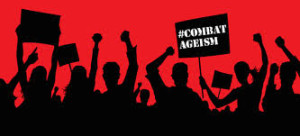 Lately I’ve been feeling the Bern. And not in good way.
Lately I’ve been feeling the Bern. And not in good way.
No, I don’t mean I have anything against presidential candidate Bernie Sanders. In fact, I am a fervent supporter. I mean I have everything against the off-hand (and insistent) ageism that has accompanied his wildly successful bid for the Democratic nomination. (And yes, I am aware that he lost big yesterday. But consider how far he’s gotten. Consider that no one, absolutely no one, thought his campaign would go anywhere.)
Perhaps it is the bluster, incivility, rudeness (not to mention sexism, racism) of Donald Trump that has dropped the bar so low that it’s now okay to make off-hand jokes about the size of Bernie Sander’s prostate. Because, haha, older men often have enlarged prostates. Which, I guess must have something to do with their ability to govern. Or hear the guy – a consistently thoughtful, energized and compassionate activist – referred to as a “grumpy old man.” His wife, to reassure everyone, has to tell the HuffPost that for Bernie, 75 is the new 55.
Because, as we all know: Old is bad. Old is sickly, grumpy, curmudgeonly. Old is stodgy. Old people, while occasionally “adorable” and frequently useful as babysitters, are generally in the way. They muck up the works.
And then there’s Bernie. Who has the energy and intensity most people never have, regardless of age. Who has the fortitude and persistence, the stamina, endurance and resilience – mentally, psychologically, physically — to mount a blow-the-pollsters-out of the water national campaign, to traipse back and forth across the country for months on end, to deliver hundreds of impassioned speeches, to capture the attention and engage the energy of younger voters…and the pundits feel called upon (allowed to) make comments about the size of his prostate.
And it’s not just the media taking these potshots, it’s ALL of us . All of us harbor negative stereotypes about older people – who, by the way, will comprise 29 percent of the U.S. population by 2017. And so if Mr. Trump makes it okay to view all who practice the Muslim religion terrorists, and all who hail from Mexico as undesirable, why shouldn’t it be open season on older people.
“Many Americans start developing stereotypes about older people during childhood, reinforce them through adulthood, and enter old age with attitudes toward their own age group as unfavorable as younger person’s attitudes.” This from a 58-page booklet published by the International Longevity Institute.
And consider this: If we’re not finding ways to dis Bernie for living on the earth as long as he has, we’re dealing with (which is to say, NOT dealing with) our embedded ageism by viewing him as an exception. His wife is reduced to making the case that for Bernie “75 is the new 55.” Because…perish the thought that a 75 year old might be actively, passionately, meaningfully engaged with the world.
March 16, 2016 2 Comments

